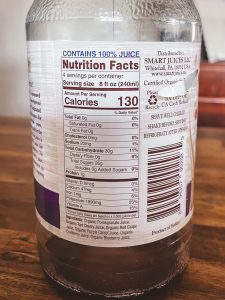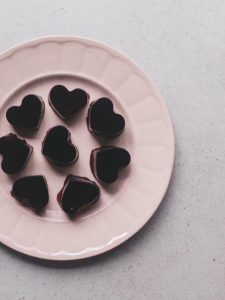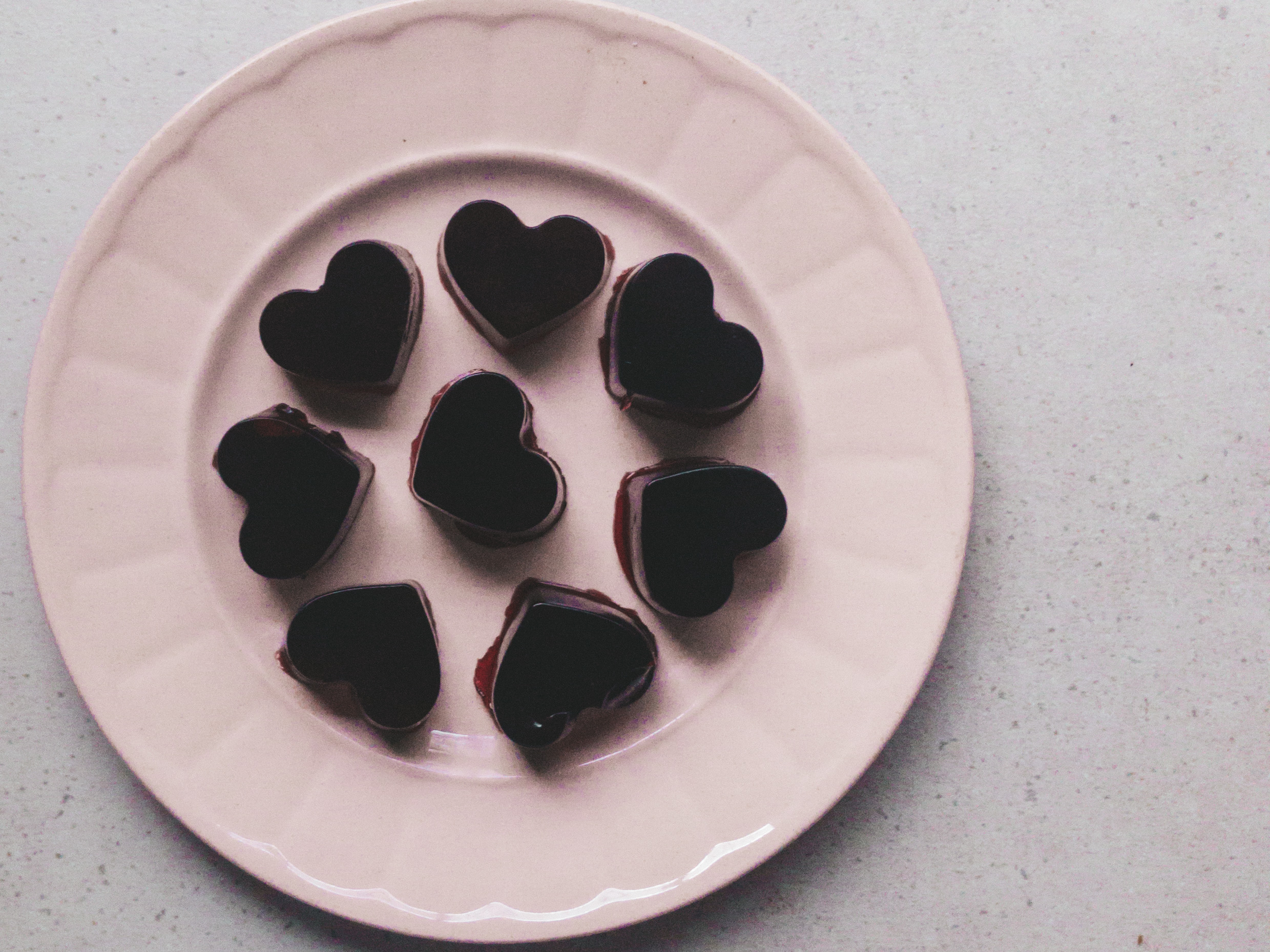For those of you who’ve been following me for a while, you’ll know I’m a big fan of gelatin gummies. It’s a simple and quick recipe that makes little treats great for the whole family, including new mamas and their little ones.
Nutritional highlights
The star of the show in this recipe is the gelatin, which is a wonderfully nourishing ingredient that is high in protein, in particular, it is is a rich source of the amino acid glycine.
Glycine is beneficial for maternal health in the following ways:
- Promotes relaxation of the nervous system and feelings of calm
- Can be useful for getting to sleep (when taken at night)
- A key amino acid that makes up collagen, which is needed for skin, hair, and nail health, and for tissue repair and healing after birth and pregnancy
The same benefits are seen for toddlers’ & children’s health – glycine supports a calm nervous system, promotes sleep when taken at night, as well as being integral for tissue formation and repair that is essential in their fast-growing bodies.
Gelatin is also commonly used to support digestive health, in particular, for maintaining good integrity of the cells that line the digestive tract. This can useful for kids, who naturally have a more open gut lining, by supporting these cells to close and tighten as they grow.
Disclaimer:
The information provided in this blog is for your personal or other non-commercial, educational purposes. It should not be considered as medical or professional advice. We recommend you consult with a GP or other healthcare professional before taking or omitting to take any action based on this blog. While the author uses best endeavours to provide accurate and true content, the author makes no guarantees or promises and assumes no liability regarding the accuracy, reliability or completeness of the information presented. The information, opinions, and recommendations presented in this blog are for general information only and any reliance on the information provided in this blog is done at your own risk.
Choosing your ingredients
With this recipe in particular, I recommend sourcing the best quality ingredients you can access and afford. This would mean gelatin that is natural and from a grass-fed origin, and using fruit juice that is pure 100% juice, with no added sugar, and ideally organic.
I use the Nutra Organics Natural Gelatin (no affiliation) and typically buy whatever organic juice I can get my hands on at whatever grocery store I’m shopping at that week.
Which juice to use
You can use any juice you like in the recipe below, including a mix of fruit & veg, except for pineapple or kiwi juice, as these contain enzymes that won’t allow the gelatin to set properly. Fresh juice will work, as will bottled juice.
Personally, I like to choose juices like blueberry, pomegranate, raspberry, or cherry, as the antioxidant content of these fruits is really high, adding another layer of nourishment, while the sugar content of these fruits is typically lower. Fresh orange juice is a nice treat when I remember, too.
Adding sweetener
You can add some liquid sweetener (explained in the recipe below) if you think you or your kids will enjoy that. This will depend on your palate and taste for sweetness. I recommend adding only a small amount so it keeps the gummies leaning more towards being an everyday food and less towards being a sugary treat that requires moderation.
When I first began making these gummies many years ago, my palate needed the extra sweetness. But as I’ve reduced my overall sugar intake over time my palate has adjusted and now the gummies are pleasantly sweet without any added sugar.

Are gummies safe for toddlers & kids?
Yes, gelatin gummies are perfectly safe for toddlers and kids. Gelatin is a naturally occurring peptide that is found in meat, so it is as safe to give to your kids as it would be to give them a meat stew. However, I would offer a few caveats to this.
Sugar content
My only hesitation with these gelatin gummies and little ones is the sugar content. Although the fruit juice is (ideally) 100% pure fruit, which offers some small nutritional benefits, the sugar content of the juice can be quite high depending on the type of juice you choose.
On top of this, if you’re adding additional sweetener (honey, maple, etc.) this increases the sugar content further, placing the gummies more in the confectionary category than in the everyday foods category, in my opinion.
Having said this, the gelatin is predominately protein, helping to balance out some of the blood sugar effects that sugary fruit juice can have in the body.
For anyone with a mind for crunching the numbers on sugar, I’ve provided an example down below.
How many should I give my kids?
There is no rule for how many you should or shouldn’t give to your child. You will need to consider the sugar content of your gummies (see the example below) in the context of your child’s overall diet. For example, are they consuming other foods with added sugar regularly?
However, as far as lollies and confectionaries go, these are an excellent alternative to conventional lollies as they offer the benefit of the natural, grass-fed gelatin, which is rich in glycine.
The full recipe below provides around 4.7g of glycine. Therapeutic doses for children are normally calculated based on their weight, so I can’t give specific numbers here, but I usually offer about 4 of these heart-shaped gummies (pictured above) to my daughter in one serve which provides around 0.5g of glycine – an appropriate dose for a child of her age (2.5 y/o). This amount will vary depending on how many gummies you end up with, but perhaps this can serve as a rough guide (my moulds make 30).
Gummies & babies
Gelatin is safe for babies. You can give gelatin to your baby from the time you introduce solids. I do advocate for a whole food approach to introducing solid foods, so offering the whole food source of gelatin is my preferred method (i.e. slow-cooked meats or bone broth that contain gelatin), however, a little bit of powdered gelatin is ok from time to time.
Babies under the age of 12 months should not have honey (due to the risk of botulism) and I would also recommend not adding sweetener of any kind to your gummies if you’re going to offer them to your baby. Fruit juice should be limited, so only offer to your baby on occasion, not as an everyday food.

An example:
For those who like to see the numbers on this, here is an example from a recent batch I made. Skip down to the recipe below if you’re not a numbers person.
You can calculate this for yourself by looking at the nutrition panel on the back of the juice container. I like to think of sugar in terms of teaspoons because it helps me to visualise how much is going in.
Now, I’m not normally a stickler like this for the sugar content of fruit. But when fruit is reduced down to juice and we lose the full food matrix with all the fibre, it essentially becomes slightly nutritious sugar water.
- 1 cup of juice for the recipe provides 26g sugar
- 1 tsp of sugar = 4g sugar
- Therefore 1 cup of juice provides 6.5 teaspoons of sugar
- For me, this recipe makes 30 gummies with my heart-shaped moulds (use the number of gummies you personally made)
- So 6.5 / 30 = 0.22 teaspoons of sugar per gummy
- My daughter usually eats 4 in one sitting, equating to 0.85 teaspoons/serve

RECIPE: Gelatin Gummies
INGREDIENTS:
- 1 cup of juice
- 2.5 tbsp gelatin
- Optional: 1-2 tablespoons liquid sweetener (like honey or maple)

METHOD:
-
Place 1/2 cup of juice in a bowl and sprinkle the gelatin on top to ‘bloom’ it. Let it sit for a few minutes until all the liquid has been absorbed
-
Meanwhile, place the other 1/2 cup of juice in a small saucepan and gently heat until just below boiling, remove from the heat
-
Add the bloomed gelatin into the warm juice and stir well until combined. A whisk is useful here.
-
Stir in the sweetener, if using, and stir to combine.
-
Pour into moulds, or into a slice or loaf tin, or any Tupperware container.
-
Place in the fridge to set for at least 1 hour. Once nearly set, I like to put them into the freezer to fully solidify for 10-15 mins, as this makes it really easy to pop them out of the moulds (I learned this trick from Georgia at Well Nourished).
-
Remove from mould, or from tin/container and cut into squares or other desired shapes.
NOTE: you can double or triple the quantities easily to make a larger batch
STORAGE:
Store in an air tight container in the fridge for 1 week.
Do gummies freeze? Some say yes, some say no. Personally, I don’t mind frozen and then defrosted gummies, but others think that the texture is compromised. Try a few for yourself to see where you sit. Freezing extends their shelf life considerably.
Disclaimer:
The information provided in this blog is for your personal or other non-commercial, educational purposes. It should not be considered as medical or professional advice. We recommend you consult with a GP or other healthcare professional before taking or omitting to take any action based on this blog. While the author uses best endeavours to provide accurate and true content, the author makes no guarantees or promises and assumes no liability regarding the accuracy, reliability or completeness of the information presented. The information, opinions, and recommendations presented in this blog are for general information only and any reliance on the information provided in this blog is done at your own risk.


0 Comments